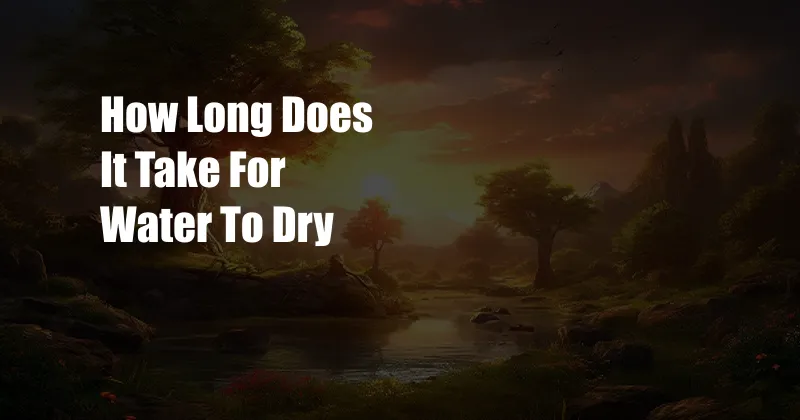
How Long Does It Take for Water to Dry?
I remember being a kid and wondering how long it took for water to dry. I would splash in puddles and then watch as the water slowly disappeared. I never really thought about what was happening, but I was always fascinated by it.
Now that I’m an adult, I know a little bit more about the science behind how water dries. And in the following paragraphs, I’ll share my knowledge with you so that you can better understand it too.
Evaporation: The Basics
When water dries, it turns into water vapor. This process is called evaporation. Water vapor is an invisible gas that exists in the air around us. Water molecules in a liquid state absorb energy and become excited. This causes them to move faster and eventually overcome the restraining force of the liquid, escaping into the atmosphere.
The rate of evaporation depends on several factors, including the amount of water, the surface area, the temperature of the water, the humidity of the air, and the movement of the air. The higher the temperature, the lower the humidity, and the greater the movement of the air, the faster the evaporation rate will be.
Factors Influencing Drying Time
- Surface area: A larger surface area allows for more water molecules to escape into the air, leading to faster evaporation.
- Temperature: As mentioned earlier, higher temperatures increase the kinetic energy of water molecules, accelerating evaporation.
- Humidity: When the air is already saturated with water vapor, the rate of evaporation decreases since there is less space for additional water molecules to occupy in the air.
- Air movement: Wind or air currents help carry away water vapor, creating a concentration gradient that draws more water molecules from the surface to evaporate.
- Amount of water: The more water present, the longer it will take to dry completely due to the increased number of water molecules that need to evaporate.
Applications and Examples
- Drying clothes: The principles of evaporation are utilized in clothes dryers, where hot air is circulated to enhance evaporation and remove moisture from wet clothes.
- Dehydration: In arid climates, people can become dehydrated if they fail to replenish lost fluids, as evaporation from the skin and lungs contributes to water loss.
- Cooling: Evaporation is a natural cooling mechanism. When sweat evaporates from the skin, it takes away heat, helping to regulate body temperature.
- Water cycle: Evaporation plays a crucial role in the water cycle, where liquid water transforms into water vapor and rises into the atmosphere, eventually forming clouds and precipitating back down as rain or snow.
Tips for Faster Drying
If you want to dry something quickly, there are a few things you can do:
- Increase the surface area. The more surface area that is exposed to the air, the faster the water will evaporate.
- Raise the temperature. The higher the temperature, the faster the water will evaporate.
- Lower the humidity. The lower the humidity, the more space there will be for water vapor in the air, allowing for faster evaporation.
- Increase the movement of the air. The more air that moves across the surface of the water, the faster the water will evaporate.
Frequently Asked Questions
Q: Why does water dry faster in the sun?
A: Sunlight provides heat, which increases the kinetic energy of water molecules and accelerates evaporation. Additionally, the sun’s rays can create air currents that further enhance evaporation.
Q: Can water dry without evaporation?
A: Yes, water can dry through a process called sublimation, where it transitions directly from a solid state to a gaseous state without passing through the liquid phase. This occurs at very low temperatures and pressures.
Q: Does the color of water affect its drying time?
A: No, the color of water has no significant impact on its drying time. The rate of evaporation primarily depends on factors such as temperature, surface area, and humidity, not the color of the water.
Conclusion
So, how long does it take for water to dry? It depends on a number of factors, but in general, the larger the surface area, the higher the temperature, the lower the humidity, and the greater the movement of the air, the faster the water will dry.
Are you fascinated by the topic of water drying? Share your thoughts and experiences in the comments section below. Your insights and questions will contribute to a more engaging and informative discussion for all readers. Let’s explore the wonders of water evaporation together!